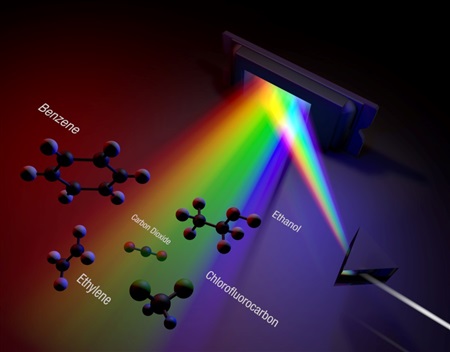SSZTBT5 december 2015
This guest blog comes from Hakki Refai, chief technology officer for Optecks , a TI DLP® Design House dedicated to developing products and solutions for DLP technology based applications.
In the previous installment of this blog series, we discussed current spectroscopy methods and the unique advantages of using DLP technology for spectroscopy. Now, let’s see how the different modules that can be integrated with the DLP NIRscan™ Nano EVM help you make the best use of its improved capabilities.
Three such modules are of interest here: high-performance transmittive, standard reflective, and fiber-coupled.

Transmittive Module:
The OTM (Optecks Transmission Module) interrogates a sample by illuminating it with an infrared source and collecting the light that is transmitted through the sample for coupling to the EVM. A cuvette holder can be used with a cuvette or equipped with mounting components for handling gas, liquid and solid samples.
Example applications of transmission-based spectroscopy include:
- Detecting the presence of target compounds in liquids, such as water in juices
- Determining the origin of a gas by its composition
- Measuring the opacity of plastic tubing used in gas and liquid flow measurements
The OTM utilizes a telecentric design to enhance SNR, and thus the DLP NIRscan Nano EVM can be used in more demanding applications – such as those with weak signals or requiring timely control of critical processes – than many of its larger, more costly competitors.
Reflective Module:
The reflective module interrogates a sample by illuminating it with an infrared source and then coupling the light reflected from the sample to the processing optics within the DLP NIRscan Nano EVM.
Example applications of reflection-based spectroscopy include:
- Analysis of cheese composition during production to ensure proper taste and texture
- Determine the quality of meat
- Rapidly identifying microorganisms in food, hospitals, and pharmaceuticals, both beneficial and potentially harmful.
Fiber-Coupled Module:
The Optecks Fiber-Coupled Module (OFCM) provides the ability to measure the spectral content of an optical signal on an optical fiber cable. The module provides optimal coupling between the optical fiber and the input aperture of the DLP NIRscan Nano EVM to maximize the collected optical power for analysis.
Example applications of the fiber-coupled module for spectroscopy include:
- Analyzing and monitoring the spectral content of a DWDM or similar signal in a fiber-optic network.
- Analysis and verification of the spectral performance of optical networking components, such as multiplexer/demultiplexers, filters (thin-film, Bragg, Fabry-Perot), and optical amplifiers.
- Monitoring and measurement of fiber-coupled, frequency-based optical sensor systems.
In addition, the module would also accept inputs from remote sample interrogation systems that utilize an optical fiber to deliver the output of the interrogator to a spectrometer for analysis.
Want to learn more about spectroscopy and its applications? Check out a few resources:
- Learn more about how DLP technology enables spectroscopy in this white paper.
- This application note explains TI DLP spectrometer design considerations.